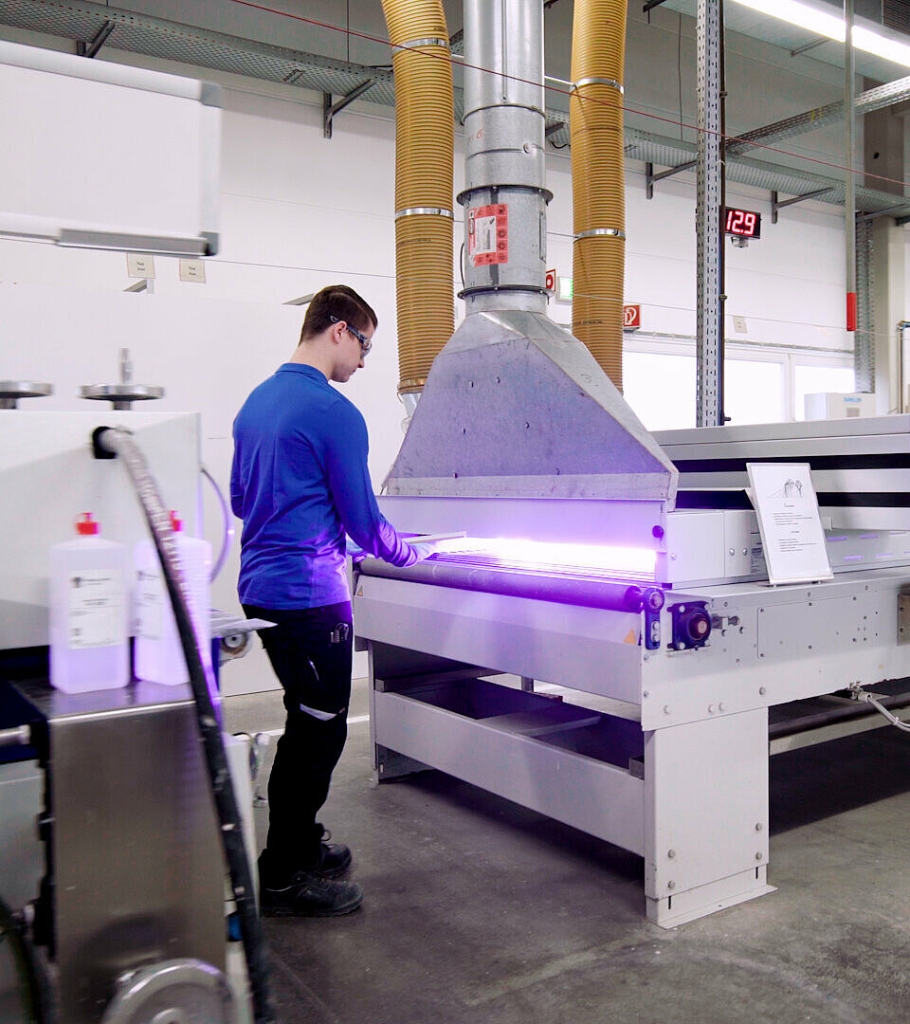How UV Curing Works with UV Wood Coatings: The Secret to a Flawless Finish

UV curing has revolutionized the wood coating industry, enabling manufacturers to achieve durable, high-quality finishes in record time. When paired with specially formulated UV wood coatings, UV curing offers a rapid, efficient way to finalize wood surfaces, leaving them ready for use or further processing within seconds. However, to ensure a flawless outcome, an essential step in this process is pre-drying—making sure the lacquer passes through a dryer before it reaches the UV lamps. In this blog, we’ll explain how UV curing works, explore its benefits, and dive into why pre-drying is so critical for achieving a perfect finish.
What Are UV Wood Coatings?
UV wood coatings are specialized lacquers engineered to cure rapidly when exposed to ultraviolet (UV) light. Commonly used in furniture manufacturing, cabinetry, and flooring, these coatings produce an exceptionally durable finish that resists wear, chemicals, and moisture. Unlike conventional lacquers that require time and ambient air to dry, UV wood coatings cure almost instantly under UV light. This accelerated process enables manufacturers to coat and cure wood surfaces in minutes, drastically reducing drying times and expediting production.
How UV Curing Works
The UV curing process begins with the application of the UV coating on the wood surface. Once the coating is applied, it needs to undergo UV curing to harden and fully bond to the wood. Here’s a closer look at the steps involved:
- Application of the UV Coating: The UV coating is applied through methods like spraying, rolling, or curtain coating, depending on the wood type, coating’s consistency, and desired finish.
- Pre-Drying Process: After application, the coating must pass through a pre-drying area or dryer before reaching the UV lamps. This step is essential because it removes excess surface moisture and levels the coating, creating a more uniform base and preparing it for optimal curing.
- UV Curing Stage: Finally, the coating reaches the UV curing lamps, where it’s exposed to a controlled wavelength of UV light. This exposure activates a photochemical reaction in the coating, causing it to harden almost instantly. Within seconds, the coating is fully cured, leaving a high-gloss or matte finish, depending on the desired outcome.
The Importance of Pre-Drying Before UV Curing
One of the most critical steps in achieving a perfect finish with UV coatings is pre-drying. This process helps ensure that any remaining solvent or moisture evaporates from the lacquer before curing begins. Here’s why pre-drying is essential:
- Avoids Trapped Solvents: Residual solvents left in the coating can become trapped once the UV curing begins, leading to bubbling, pinholes, or blisters. Pre-drying helps eliminate these issues.
- Ensures Even Coverage: Pre-drying also aids in evenly distributing the coating across the wood’s surface. Without this stage, the coating can appear inconsistent or uneven, which could impact both appearance and durability.
- Improves Adhesion: A pre-dried coating adheres better to the wood surface, creating a stronger bond and enhancing the coating’s durability.
- Optimizes Finish Quality: By pre-drying before curing, you minimize the chance of irregularities or imperfections, resulting in a smoother, more professional finish.
Key Benefits of UV Curing for Wood Coatings
- Speed and Efficiency: UV curing is extremely fast. Traditional lacquers can take hours or even days to dry completely, whereas UV wood coatings cure in seconds. This speed makes UV curing ideal for high-volume production.
- Superior Durability: UV coatings provide outstanding resistance to scratches, chemicals, and environmental damage, making them ideal for high-wear surfaces like tables, floors, and cabinets.
- Eco-Friendly Process: Many UV coatings are low in volatile organic compounds (VOCs), leading to fewer harmful emissions during the curing process. Pre-drying also contributes to an environmentally friendly workflow by ensuring that any residual solvents evaporate effectively, reducing overall emissions.
- Reduced Waste: The controlled nature of UV curing minimizes material wastage. Pre-drying further supports this by ensuring that the lacquer is in its optimal state before curing, reducing the risk of coating defects that require reapplication.
When UV Curing Might Be Right for You
For manufacturers, UV curing is a game-changing technology that significantly enhances both efficiency and product quality. Here are a few cases where UV curing could be particularly advantageous:
- High-Volume Production: When coating large quantities of wood surfaces quickly and efficiently is a priority, UV curing speeds up the process without compromising quality.
- High-Durability Requirements: UV coatings offer excellent durability, making them ideal for furniture, cabinetry, and flooring where a long-lasting finish is essential.
- Eco-Friendly Manufacturing: By reducing VOC emissions and minimizing waste, UV curing aligns with sustainable practices—a priority for today’s environmentally conscious manufacturers.
Conclusion
UV curing is a powerful technology for finalizing wood coatings, especially when prepared through pre-drying. This essential step ensures that solvents are eliminated, coverage is even, and adhesion is maximized before the curing process begins. The result? A durable, flawless finish that enhances the wood’s appearance and longevity.
If you’re considering UV curing for your next wood coating project, remember: pre-drying is key to a perfect finish. Following this step can help you maximize the benefits of UV curing, speeding up production, minimizing waste, and achieving a premium, long-lasting result.
By understanding how UV drying works and its benefits, businesses can take full advantage of this cutting-edge technology to enhance their production processes while minimizing environmental impact.
